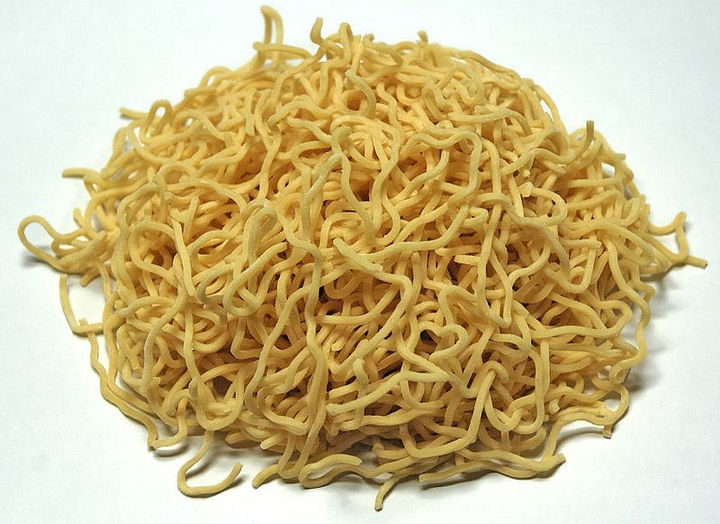Ramen noodles are not a dish that is associated with a good meal or anything near healthy. It gives a nostalgia for college days and eating them in your dorm after the cafeteria closed. These fried noodles are full of salt and have no protein or veggies. Most Americans equate ramen to the inexpensive fried noodles that come with the little seasoning packets. But there is a world of ramen outside of the little orange and red plastic and styrofoam containers they come in.
Ramen is not inherently unhealthy, but the flavor packet provided in instant ramen does contain high amounts of sodium. Diets high in sodium are associated with an increased risk of developing high blood pressure, a leading cause of stroke and heart disease, according to the Centers for Disease Control and Prevention.

Where Do Ramen Noodles Come From?
It is believed that ramen noodles originated in China and were eventually introduced to Japan. But ramen is a common and popular dish in Japanese diets and throughout all of Asia. Japan has a large selection of dried, pre-packaged ramen containers ready to be boiled and seasoned. But fresh ramen can be found literally everywhere, including tiny alleyways to ramen restaurants.Â
Another difference in Japan is the presence of vegetables. A bowl of fresh ramen may have an abundance of vegetables that may include:
- bean sproutsÂ
- bamboo shoots
- scallionsÂ
- leeks
- seaweed
- other green veggies
Also, fresh ramen will contain some protein in Japan. The most popular choice is a slice of pork. Some come with a fish paste or cake, and some with a soft-boiled egg. You may also find fried tofu.
Are Ramen Noodles Healthy?
Is there a difference between the noodles we see in Japan and those eaten here? Is ramen noodle nutrition different? Most noodles in Japan are fresh. Every shop does not make noodles from scratch, but larger cities will have famous shops that hand-make their noodles. Also, the broth will provide the flavor, which consists of pork, soy, miso, or salt. You can find some fish stock, but most broths are meat-based and high in sodium. But the Japanese do not drink all of the broth.
Ramen noodles have been shown to increase metabolic syndrome in women. The ones who eat instant noodles over two times a week, are 68% more at risk to develop metabolic syndrome. This is regardless of how many other healthy dishes they eat or if they have a high level of physical activity. The culprit is the highly processed ingredients like saturated fat and high sodium. They contribute to high blood sugar, high blood pressure, heart disease, stroke, and diabetes.Â
Heart disease includes the risk of heart failure. Sodium is a direct cause of increased blood pressure which can directly lead to stroke and heart failure. According to USDA.gov, generic ramen noodles contain 1503 mg of sodium, which comes around to 65% of the daily FDA-recommended intake. They can elevate your combined daily salt intake without you knowing. Your risk increases each time you eat packaged ramen noodles.
What Happens To Your Body When You Eat Instant Ramen Daily
FAQ
How unhealthy is real ramen?
How often can I eat instant noodles?
Are ramen noodles bad for you without the packet?
Is there such thing as healthy ramen?
Are ramen noodles bad for You?
Heart disease includes the risk of heart failure. Sodium is a direct cause of increased blood pressure which can directly lead to stroke and heart failure. According to USDA.gov, generic ramen noodles contain 1503 mg of sodium, which comes around to 65% of the daily FDA-recommended intake.
Are ramen noodles gluten free?
Ramen noodles are not gluten free as their main ingredient is wheat flour. The wheat based ramen noodles or refined wheat flour ramen noodles are cut into noodle strips from a dough of wheat. Wheat and its products contain gluten which are not suitable to ingest by individuals who have gluten intolerance. Gluten free ramen are now a days introduced into the market.
Are instant ramen noodles safe?
Though these ingredients have been linked to several adverse health effects in large doses, the small amounts found in food are likely safe in moderation. However, those who are particularly sensitive to additives like MSG may want to steer clear of instant ramen noodles, as well as other highly processed foods.
Do Japanese eat ramen noodles?
Also, the broth will provide the flavor, which consists of pork, soy, miso, or salt. You can find some fish stock, but most broths are meat-based and high in sodium. But the Japanese do not drink all of the broth. Ramen noodles have been shown to increase metabolic syndrome in women.
